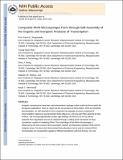Composite RNAi-Microsponges Form through Self-Assembly of the Organic and Inorganic Products of Transcription
Author(s)
Roh, Young Hoon; Deng, Zhou J.; Shopsowitz, Kevin; Morton, Stephen Winford; Hammond, Paula T
DownloadHammond_RNAi-microsponges.pdf (2.278Mb)
OPEN_ACCESS_POLICY
Open Access Policy
Creative Commons Attribution-Noncommercial-Share Alike
Alternative title
RNAi-Microsponges Form through Self-Assembly of the Organic and Inorganic Products of Transcription
Terms of use
Metadata
Show full item recordAbstract
Inorganic nanostructures have been used extensively to package nucleic acids into forms useful for therapeutic applications. Here we report that the two products of transcription, RNA and inorganic pyrophosphate, can self-assemble to form composite microsponge structures composed of nanocrystalline magnesium pyrophosphate sheets (Mg[subscript 2]P[subscript 2]O[subscript 7]•3.5H[subscript 2]O) with RNA adsorbed to their surfaces. The microsponge particles contain high loadings of RNA (15–21 wt.%) that are protected from degradation and can be obtained through a rolling circle mechanism as large concatemers capable of mediating RNAi. The morphology of the RNAi microsponges is influenced by the time-course of the transcription reaction and interactions between RNA and the inorganic phase. Previous work demonstrated that polycations can be used to condense RNAi microsponges into nanoparticles capable of efficient transfection with low toxicity. Our new findings suggest that the formation of these nanoparticles is mediated by the gradual dissolution of magnesium pyrophosphate that occurs in the presence of polycations. The simple one-pot approach for assembling RNAi microsponges along with their unique properties could make them useful for RNA-based therapeutics.
Date issued
2013-12Department
Massachusetts Institute of Technology. Department of Chemical Engineering; Koch Institute for Integrative Cancer Research at MITJournal
Small
Publisher
Wiley Blackwell
Citation
Shopsowitz, Kevin E., Young Hoon Roh, Zhou J. Deng, Stephen W. Morton, and Paula T. Hammond. “RNAi-Microsponges Form through Self-Assembly of the Organic and Inorganic Products of Transcription.” Small 10, no. 8 (December 19, 2013): 1623–1633.
Version: Author's final manuscript
ISSN
16136810
1613-6829